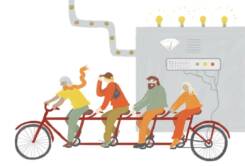Key principles of earnings-related pension and the earnings-related pension system
Earnings-related pensions and the earnings-related pension system have a wide range of details. Included are a few key principles that are implemented in the same way regardless of the sector, the type of pension, or the administrator providing the earnings-related pension.
On this page, we review the principles of the earnings-related pension system from the perspectives of both the accrual of individuals’ earnings-related pensions and the relevant pension system.
Content of this page
Key principles of earnings-related pensions
Several pension acts
Several pension acts have provisions on how statutory earnings-related pension is determined. The Employees Pensions Act (TyEL) serves as a general act concerning pension provision in the private sector. The Public Sector Pensions Act (JuEL) and the Seafarers’ Pensions Act (MEL) also lay down statutory provisions determined on the basis of an employment relationship. The Self-Employed Persons’ Pensions Act (YEL) and the Farmers’ Pensions Act (MYEL) include provisions on the pension determined by virtue of work done when being self-employed.
It can roughly be said that
- TyEL and MEL apply to pensions accruing in private-sector employment
- JuEL applies to pensions accruing in public-sector employment
- YEL and MYEL apply to pensions accruing on the basis of private-sector work as self-employed
- MYEL also applies to pensions that accrue from artistic or scientific grants or scholarships.
Insurance under the Employees Pensions Act, the Self-Employed Persons’ Pensions Act and the Seafarers’ Pensions Act is arranged with earnings-related pension providers in the private sector. Work in accordance with the Public Sector Pensions Act is insured with earnings-related pension insurers in the public sector. The Seafarers’ Pension Fund, which insures work defined in the Seafarers’ Pensions Act, and Mela, which insures enterprise activities in keeping with the Farmers’ Pensions Act, are specially tasked institutions established by law.
Certain principles apply regardless of the law
The details of the laws governing the determination of statutory earnings-related pensions differ somewhat. However, from the perspective of gainfully employed persons, certain principles are the same, regardless of the law under which the earnings-related pension accrues.
Mandatory insurance in the event of old age, disability, or the death of the family’s breadwinner
Insurance of work done as an employee and a self-employed person is mandatory in Finland. This makes our earnings-related pension system very comprehensive. Work done as an employee must be insured when the earnings from the work exceed EUR 70,08 per month (in 2025). Insurance in accordance with the Self-Employed Persons’ Pensions Act must be taken out when the confirmed income from working as a self-employed person exceeds EUR 9,208.43 per year (in 2025). In the case of farmers and grant recipients, the corresponding lower limit for confirmed income is EUR 4,605 (in 2025).
The statutory earnings-related pension provides protection against old age, disability and the death of the family’s breadwinner. Apart from old-age pension, the pension benefits proper include partial old-age pension, disability pension, partial disability pension, and years-of-service pension. Upon the death of a family’s breadwinner, survivors’ pensions (i.e. the surviving spouse’s and orphan’s pensions) help secure the livelihood of children and widows under certain conditions.
The various pension benefits are described in more detail on the Työeläke.fi website:
The earnings-related pension system also offers the possibility of vocational rehabilitation when an employee’s or self-employed person’s ability to work is threatened. Rehabilitation allowance and partial rehabilitation allowance are paid to persons participating in the earnings-related rehabilitation provided under the earnings-related pension system. The pecuniary compensation for vocational rehabilitation is always higher than disability pension.
Earnings-related pensions are based on wages earned
The accrual of a pension is individual, i.e. it is based on a person’s own earnings during his or her career and on fees collected accordingly. Risks related to people’s longevity, disability and the death of the family’s breadwinner, as well as the risks associated with the financing of earnings-related pensions, are borne jointly (collective risk-taking).
The principles applied to the accrual of earnings-related pensions are laid down by law. The pension accrued from the employment relationship is based on the employee’s wages subject to withholding tax. The pension accrued in accordance with the Self-Employed Persons’ Pensions Act is based on the concept of confirmed income. According to the Farmers’ Pensions Act, the total confirmed income is determined on the basis of its own special criteria defined by law.
Earnings-related pensions also accrue for some unpaid periods. Such periods include, under certain conditions, parental leave and home care allowance, unemployment, and studies leading to a degree.
More information on the accrual of earnings-related pensions is available on the Työeläke.fi website:
The pension earned accompanies you and retains its value
The accrued earnings-related pension accompanies you irrespective of any job changes. This principle, known as the vesting principle, applies not only to job changes but also to situations where an employee becomes self-employed and vice versa The vesting principle contributes to the vocational mobility of the labour force and makes it possible to change jobs towards the end of one’s career without fear of losing pension that has already been earned.
Both earned and disbursed earnings-related pensions retain their value by means of index linking. At present, earnings-related pensions are determined on the basis of total earnings throughout the career. When determining a pension, the income from past years is raised to correspond to the wage level and consumer prices at the time the pension begins, using the so-called wage coefficient. Pensions that are already being disbursed are adjusted annually by the earnings-related pension index.
Pension accrual on the same grounds for all work
With regard to work performed in an employment relationship, pension accrues on the same grounds for all work, i.e. also for work performed under fixed-term and part-time employment contracts. Statutory pension also accrues on the same grounds in all sectors. This helps to support the vocational mobility of the labour force and enables job changes without frictional factors owing to retirement.
An exception to this rule is pension provision for people who worked in the public sector: until the mid-1990s, their pension accrued on better terms than in the private sector. Better public-sector pensions are still being paid, but to benefit from this better security, the employee must retire from work in the public sector.
Main financial responsibility vested in employers and employees
Employees’ earnings-related pensions are chiefly financed by pension contributions collected from employers and employees. However, the State contributes to the financing of pensions under the Seafarers’ Pensions Act by paying less than one third of the annual pension expenses.
In addition, the State finances unpaid periods for studies leading to a degree and for home care allowance. The Employment Fund, in turn, finances the accrual of pensions during periods of earnings-related unemployment.
The financing of the various earnings-related pension systems has been described in greater detail on our page Principles of financing.
Special features of pensions for self-employed persons
Self-employed persons and farmers have somewhat different pension systems from those of employees. The most substantial differences arise from the foundations of pension accrual.
- According to the Self-Employed Persons’ Pensions Act, the insurable earnings are determined on the basis of the concept of confirmed income. In keeping with the Act, income must correspond to the salary that would have to be paid if the self-employed person’s work were done by another equally skilled person.
- According to the Farmers’ Pensions Act, insurable earnings are determined for farmers, forest owners, reindeer herders and fishermen on the basis of their confirmed MYEL income. MYEL income, on the other hand, is affected, for example, by the area of cultivated fields and/or forests, the number of registered reindeer and the share of confirmed income in a fishing enterprise.
- For recipients of scientific or artistic grants, the insurable earnings are determined on the basis of the grant awarded for the work.
Unlike for employees, a pension under the Self-Employed Persons’ Pensions Act does not accrue income above a certain annual limit (EUR 209,125 in 2025). Moreover, no YEL contribution is charged for the self-employed person’s income that exceeds said income limit.
Self-employed persons are themselves responsible for their pension contributions. However, a starting entrepreneur receives a 22% discount on the YEL contribution for the first 48 months of activities.
Farmers are also responsible for their own pension contributions. The pension contributions of both self-employed persons and farmers are tax deductible.
The State participates in the payment of pensions for farmers in accordance with the Self-Employed Persons’ Pensions Act and the Farmers’ Pensions Act. The State’s share of the pension expenditure of self-employed persons has risen over the years, and was about 32 per cent in 2023. The State accounts for about 75 per cent of farmers’ pension and social benefit system (2024).
Key principles associated with implementation of the earnings-related pension system
Implementation of the Finnish earnings-related pension system is decentralized among a number of pension providers. Some pension providers are private companies by their legal nature, while others are operators established by law. In addition, some pension providers in the private sector compete against each other over clients.
Despite the multi-operator model, the person retiring only needs to deal with one pension provider.
Principle of the last insurer makes it easier to apply for a pension
At present, earnings-related pensions accrue on the basis of total earnings throughout the career. These earnings typically accrue on the basis of several employment relationships and may also include periods of full-time or part-time self-employment.
An individual’s work may therefore be insured with several pension providers during his or her work history. However, a person need not apply for a pension from several places when retiring. In keeping with the principle of a one-stop shop, the retiree obtains the pension from the pension provider where he or she was last insured.
Known as the principle of the last insurer, this system was adopted in 2004. Accordingly, the pension application is submitted to the pension provider where the insured was last registered. This earnings-related pension provider grants and pays the person the earnings-related pension accrued throughout his or her career, and invoices the related costs through the mutual cost-sharing system between the earnings-related pension providers through which the retiree has been insured during the work history.
Separate pension providers in the private and public sectors
Pension providers in the private sector are private pension insurance companies as well as company pension funds and industry-wide pension funds that provide statutory pension security. They are allowed to insure earnings under the Employees Pensions Act and the Self-Employed Persons’ Pensions Act.
The Seafarers’ Pension Fund and the Farmers’ Social Insurance Institution (Mela) are also among the actors that insure work in the private sector. However, the Seafarers’ Pension Fund may only insure work in accordance with the Seafarers’ Pensions Act. Mela, in turn, has the exclusive right to insurance determined in the Farmers’ Pensions Act.
The public sector pension provider is Keva, which manages the employment pension security of employees in the municipal sector, wellbeing services counties, the State, the Evangelical Lutheran Church, Kela and the Bank of Finland employees. However, Keva’s role varies when it comes to the financing of pensions.
In the case of municipal and wellbeing services counties employees, Keva is responsible for both pension provision and its funding. All Finnish cities, municipalities and joint municipal boards, wellbeing services counties as well as most municipal associations and limited liability companies, are members of Keva.
Services to other employers are restricted to the payment of pensions. Other actors responsible for the financing of pensions and the investment of pension assets: State Pension Fund, Church Pension Fund, Kela and the Bank of Finland.
The various pension providers are described in more detail on our page Different types of pension providers.
Authorized pension providers in the private sector compete with each other
Under certain conditions, private-sector insurers compete with each other to insure employees and self-employed persons. Competition applies to the efficiency of pension providers’ own operations and the service they provide for their customers, and also to the returns on the investment of pension assets.
The starting point for competition between private-sector pension providers is the employer’s possibility to make a selection. However, by virtue of the Farmers’ Pensions Act, only Mela is responsible for implementing the Act. Similarly, the Seafarers’ Pension Fund bears the sole responsibility for insurance in accordance with the Seafarers’ Pensions Act.
Employers operating in the private sector, under certain conditions, can choose whether they arrange statutory pension provision themselves or purchase insurance from an insurance company. Employers can arrange the insurance themselves by setting up a company-specific pension fund or by joining a pension fund operating in a certain sector.
More information on earnings-related competition is available on our page Competition in the sector of earnings-related pensions.
Funds as an element in the financing of pensions
There are two main options for financing earnings-based pension systems: full funding and a pure pay-as-you-go scheme.
- In a fully funded scheme, pension contributions are collected and placed into funds each year to the extent necessary to pay the pensions earned in that year at the time they are paid. In this method of financing, the return on funded pension assets is also available to finance pensions.
- In the pure pay-as-you-go system, the sum total of the pension contributions collected annually equals the sum needed to pay pensions in that year.
- In a partially funded system, these two alternative ways of financing earnings-related pensions are combined: some of the pension contributions collected annually from employers and employees are placed into funds, i.e. saved and invested for pensions that will be paid in the future.
In Finland, the pension systems of self-employed persons and farmers operate according to the principles of the pay-as-you-go system. The pension systems of private-sector employees and seafarers operate according to the partially funded principle.
Pension schemes for public-sector employees operate on the pay-as-you-go basis, but have been merged with buffer funds that reduce the pressure to raise earnings-related pension contributions in the future.
The financing of the various earnings-related pension systems has been described in greater detail on our page Principles of financing.


